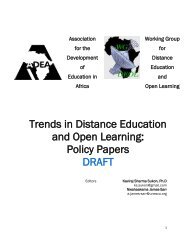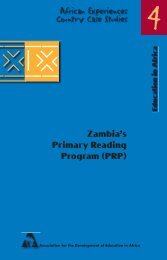Newsletter Vol.16 No.3 - ADEA
Newsletter Vol.16 No.3 - ADEA
Newsletter Vol.16 No.3 - ADEA
Create successful ePaper yourself
Turn your PDF publications into a flip-book with our unique Google optimized e-Paper software.
Secondary Educationconstrained and will remain so for manyyears to come.Many countries have not yet abandonedthe practice of selection in favorof certification. The move from selectingprimary graduates based on norms ratherthan on competence has taken placein Asia and Latin America. Why shouldthe majority of African youth fail theirjunior secondary school exams, whiletheir counterparts in OECD countriessucceed at the rate of over 60 to 70 %?Review the programs,build a new modelWhat are the goals of secondary education,and why is the public investing in it?Stakeholders include not only communitiesand parents, but also enterprises andindustry. NGOs, churches and specialinterest groups representing non-religiouscultural, ethnic and scientificinterests also have a stake in secondaryeducation.Sub-Saharan Africa needs a modelof sustainable primary and junior secondaryeducation. A high-quality juniorsecondary education should includesubjects in four areas of knowledge andskills: science and mathematics; social,life, and “geo-world” skills; ICT and technology;and language and communication.At the senior secondary educationlevel the picture becomes more complex,and a menu of demand-driven provisionsneeds to be established. Lessons fromSouth Korea, Chile, Scotland, Denmark,and the Netherlands can be applied tothe African context. In these countriesvocational and technical education andtraining have merged into flexible pathways,where the student can choose anorientation based on emerging job orprofessional needs and interests. Theconcept of key skills or competenciesis now generally accepted in OECDcountries. These countries have alsoanswered the question of “what degreeof vocational orientation?” Junior secondaryeducation should allow studentsto master general pre-vocational skills.Training for specific jobs should takeplace later and be directed by employersand enterprises. Senior secondary schoolshould be close to the world of work andprepare youngsters for the transition. Butthis is not identical to “job-training.”This debate has just started in Africa,and there is a need to adapt the OECDmodel of secondary education to thespecific needs of the region. Africansecondary schools should begin by makingmore flexible the transitions betweenlevels and by developing structured andrelevant curricula. International trendsindicate the need for vocational andtechnical options, using modern andcost-saving ICT technologies. Thesechanges will have a significant impacton the market for textbooks and learningmaterials and equipment in Africa.Promote nationalconsultations and debateInstituting these reforms will require nationaldebate and training and supportfor teachers, school managers and nonteachingstaff. They will not succeed ifteachers and parents have not boughtinto the change. Africans will need torethink their approach to education anddisconnect from traditional post-colonialsystems. This is no easy task. Forexample, achieving scientific and technologicalliteracy requires more thanunderstanding concepts and processesof science and technology. Studentsneed to gain an understanding of howscience and technology shape theirenvironment and life. This means thatthese subjects should be learned in differentways. Simple memorization andfactual learning do not lead to scientificand technological literacy. The mostcommon approach in OECD countriesis to focus on science- and technologyrelatedsocial and economic problems,such as environmentally sustainablestrategies, healthy lifestyles, HIV/AIDSand disease risks, public resource use,and population growth. This includes ageneral understanding of the nature andhistory of science and technology.The physical school environmentrequires our specific attention as well.Most boarding facilities in Africa’s secondaryschools are neglected. When adolescentslive in undignified conditions,it is unlikely they will gain self-respectand respect for others, develop healthylife styles, and make a smooth transitionto the world of work.There is also a need to institute newteaching and learning mechanisms forthe large proportion of sub-SaharanAfrica’s out-of-school youth, who requirealternative pathways to productive lives.The time has come for sub-SaharanAfrica to renew its secondary educationprograms and to create the critical massof skilled workers and youth necessaryfor the continent’s economic and socialdevelopment. Education for All at theprimary level should remain the priority,but it is not enough. Enlarging the focusto include secondary education willrequire national debates, intensifiedregional cooperation, and a fundamentalrestructuring of current systems. Itwill also require all African countriesto revisit their systems’ cost-efficiency,quality, and relevance of output. Thesereforms will take time, probably no lessthan eight to ten years. Therefore wemust start now and not wait until thenumbers of primary graduates swelleven more.The SEIA study aims to help thisprocess and to stimulate the dialoguebetween African stakeholders and thedonor community. ▼For more information on SEIA:www.worldbank.org/afr/seia6 <strong>ADEA</strong> <strong>Newsletter</strong> July - September 2004
















